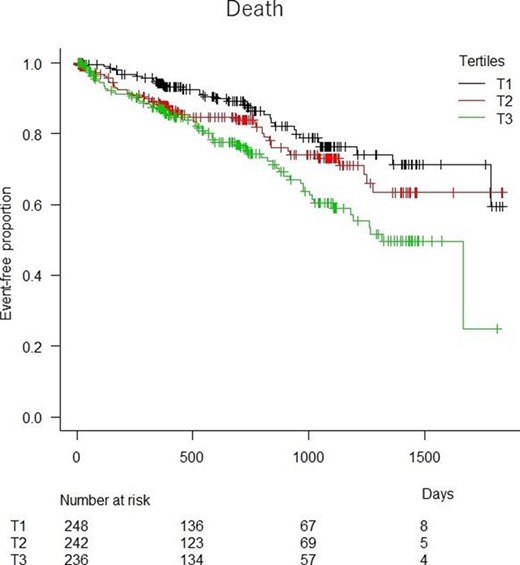-
PDF
- Split View
-
Views
-
Cite
Cite
Y Nakagawa, M Sairyo, K Miyazawa, S Tamaki, M Yano, T Hayashi, T Yamada, Y Yasumura, S Hikoso, Y Sotomi, Y Sakata, OCVC-Heart Failure investigator , Insight into the relationship between heart rate and mortality in patients in sinus rhythm with heart failure with preserved ejection fraction, European Heart Journal, Volume 43, Issue Supplement_2, October 2022, ehac544.772, https://doi.org/10.1093/eurheartj/ehac544.772
Close - Share Icon Share
Abstract
There are several reports showing that elevated heart rate (HR) is associated with poor outcomes in patients in sinus rhythm (SR) with heart failure with preserved ejection fraction (HFpEF), although the association is weak or none in HFpEF patients with atrial fibrillation (Af). However, in previous studies, cardiac and non-cardiac factors which may be associated with elevated HR, have not been fully adjusted for.
The purpose of this study is to explore covariates of elevated HR and to investigate the relationship between heart rate and mortality in HFpEF patients in SR.
Of the 1161 patients, who registered prospective multicenter, observational study of patients with HFpEF (PURSUIT-HFpEF), 726 patients in SR were examined. We performed laboratory testing and echocardiography in the compensated stage (in stable condition after treatment of acute decompensated HF). Geriatric nutritional risk index (GNRI) was calculated as nutrition index. Resting heart rate (HR) was analyzed as categorical (tertiles, T1–3). We followed the patients for median of 598 days (interquartile range 329–1028 days) to observe the outcome all-cause mortality.
The Kaplan analysis revealed that there was a significant difference between heart rate and mortality (log-rank, p=0.001). Characteristics were compared between patients in T1 (HR ≤63) and T3 (HR ≥75). There were no differences in cardiac factors between patients in T1 and T3. C-reactive protein (CRP) was significantly higher in patients in T3 than those in T1 (p=0.0004,). GNRI was significantly lower in patients in T3 than those in T1 (p=0.001). After adjustment for covariates including N-terminal pro-B type natriuretic peptide and estimated glomerular filtration rate, CRP and GNRI significantly correlated with HR (continuous variable) by multiple regression analysis (beta-coefficient = 1.52, p=0.003 and beta-coefficient = −0.14, p=0.04, respectively). Taking T1 as the reference, multivariable Cox regression analysis revealed that T3 was independently associated with mortality (hazard ratio: 2.10, 95% confidence interval: 1.33–3.32, p=0.001).
Although elevated HR was associated with enhanced inflammation and malnutrition, it itself was an independent predictor of death in HFpEF patients in SR.
Type of funding sources: Private company. Main funding source(s): Roche Diagnosis K.K.Fuji Film Toyama Chemical Co. Ltd.

Figure 1
- aging
- atrial fibrillation
- echocardiography
- heart rate
- inflammation
- heart failure
- geriatrics
- malnutrition
- laboratory techniques and procedures
- c-reactive protein
- diagnosis
- heart
- mortality
- science of nutrition
- sinus rhythm
- natriuretic peptides
- older adult
- cox proportional hazards models
- glomerular filtration rate, estimated
- interval data
- heart failure with preserved ejection fraction



